Easter island
THIS PAGE IS UNDER CONSTRUCTION
The ancient grass on the island was tough and capable of being made into ropes. That grass has since almost disappeared due to sheep-herding and over-grazing. The ropes were wrapped around the statue, which was made to act as a pulley. A large group of men, perhaps 30, would pull one end of the rope, pulling one side of the statue forward. A smaller group would act as a counterweight, pulling backwards on the other end. In this way, one side of the statute could be pulled a few feet forward. Then, the process was reversed, so that the other side of the statute would come equal to the first. In this way, over a period of months, a statute could be walked for miles down to the ocean. Then, it was placed in line with other statues, all of them facing away from the sea, looking towards the center of the island.
This process was difficult. If a statue fell over in transit, as it often did, it was too heavy to be pulled upright again, so instead the islanders went back and carved another statue.
Because the making and movement of these statues required the cooperation of the entire population of the island, the people must have believed that their gods required them to build these statues.
At its peak, the population of Easter Island is believed to have reached 11,000. Finally, the resources of the island became exhausted and the people resorted to cannibalism and began eating each other. Work on the statues stopped and the statutes were knocked over. When the first Europeans finally arrived on the island, most of these people had died out.
That is just one theory, but there are other theories too. This matter has still not yet been solved. Even this theory does not address all the mysteries regarding Easter Island.
The Easter Islanders had their own system of writing, different from any other in the world. No other Pacific Islanders knew how to write. The American Indians did not know how to write either. Who taught the Easter Islanders how to write, or did they develop their own system? Remember that writing was first invented in Asia only a few thousand years BC.
The Easter Islanders lived off sweet potatoes, which they farmed. These sweet potatoes came from the Americas. How did the Easter Islanders get them? It is possible that a few Easter Islanders traveled 2300 miles to Chile, got sweet potatoes, and brought them back? This seems unlikely. Remember that the distances involved were great, further than the distance from Europe to the closest place in the Americas, which was only colonized in 1492. Could Easter Island have been colonized by people from Chile? This was the theory which formed the basis for the book and movie Kon-Tiki. Yet, DNA taken from graves dug up on Easter Island have shown that these people were Polynesians, not American Indians. The Polynesians lived on the sea and knew how to travel thousands of miles in their small canoes. They knew where they were going. The American Indians did not know how to do that. Yet, a few American Indians could have reached Easter Island, because of a storm, and brought the seeds of sweet potatoes with them. Also, the seeds could have been brought in the stomachs of birds.
As you can see, there are several theories regarding Easter Island and the statues that reside there to this very day. Many theories have even suggested the intervention of extra terrestrials from alien planets. Easter Island continues to be one of the world's greatest unexplained mysteries.
This process was difficult. If a statue fell over in transit, as it often did, it was too heavy to be pulled upright again, so instead the islanders went back and carved another statue.
Because the making and movement of these statues required the cooperation of the entire population of the island, the people must have believed that their gods required them to build these statues.
At its peak, the population of Easter Island is believed to have reached 11,000. Finally, the resources of the island became exhausted and the people resorted to cannibalism and began eating each other. Work on the statues stopped and the statutes were knocked over. When the first Europeans finally arrived on the island, most of these people had died out.
That is just one theory, but there are other theories too. This matter has still not yet been solved. Even this theory does not address all the mysteries regarding Easter Island.
The Easter Islanders had their own system of writing, different from any other in the world. No other Pacific Islanders knew how to write. The American Indians did not know how to write either. Who taught the Easter Islanders how to write, or did they develop their own system? Remember that writing was first invented in Asia only a few thousand years BC.
The Easter Islanders lived off sweet potatoes, which they farmed. These sweet potatoes came from the Americas. How did the Easter Islanders get them? It is possible that a few Easter Islanders traveled 2300 miles to Chile, got sweet potatoes, and brought them back? This seems unlikely. Remember that the distances involved were great, further than the distance from Europe to the closest place in the Americas, which was only colonized in 1492. Could Easter Island have been colonized by people from Chile? This was the theory which formed the basis for the book and movie Kon-Tiki. Yet, DNA taken from graves dug up on Easter Island have shown that these people were Polynesians, not American Indians. The Polynesians lived on the sea and knew how to travel thousands of miles in their small canoes. They knew where they were going. The American Indians did not know how to do that. Yet, a few American Indians could have reached Easter Island, because of a storm, and brought the seeds of sweet potatoes with them. Also, the seeds could have been brought in the stomachs of birds.
As you can see, there are several theories regarding Easter Island and the statues that reside there to this very day. Many theories have even suggested the intervention of extra terrestrials from alien planets. Easter Island continues to be one of the world's greatest unexplained mysteries.

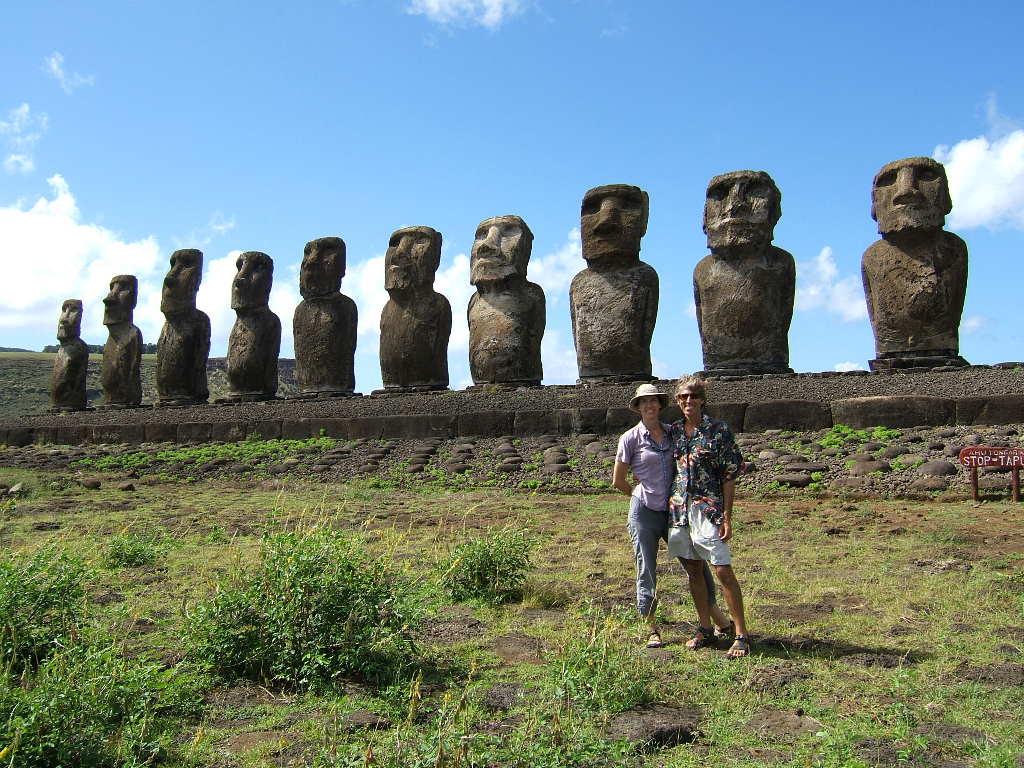
Double click here to edit this text.

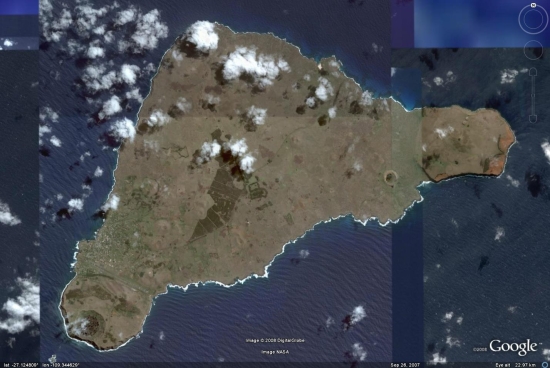
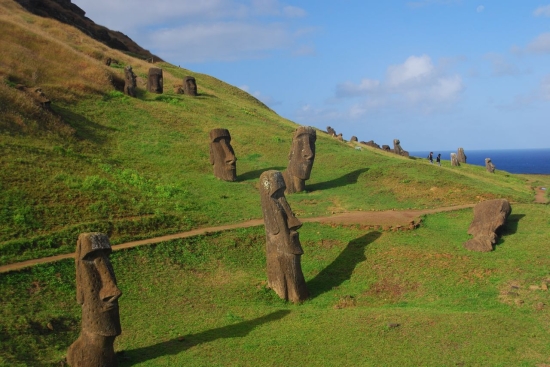
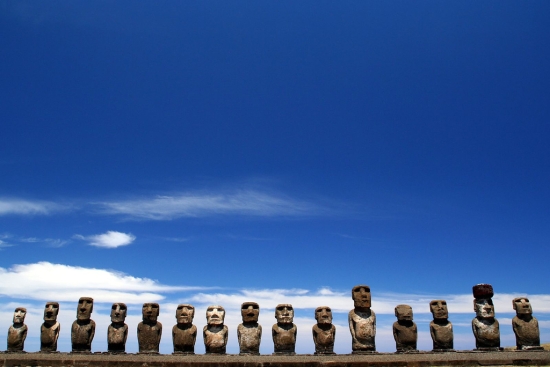
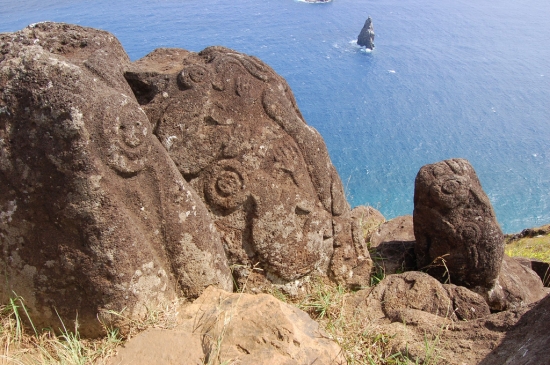
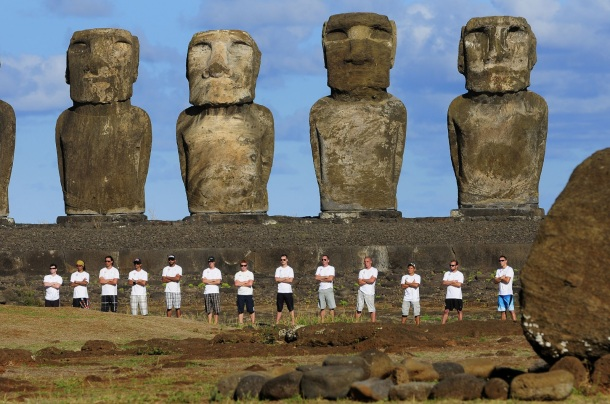
Above picture show a scale between humans and the structures
GOOGLE EARTH


Easter Island
Sun, 6th November, 2011
Rapa Nui
Please Sign Guestbook
Introduction
Located in the Pacific Ocean at 27 degrees south of the equator and some 2200 miles (3600 kilometers) off the coast of Chile, Easter Island is
considered to be the world's most remote inhabited island.
One of the world's most famous yet least visited archaeological sites, Easter Island is a small, hilly, now treeless island of volcanic origin. Located in the Pacific Ocean at 27 degrees south of the equator and some 2200 miles (3600 kilometers) off the coast of Chile, it is considered to be the world's most remote inhabited island. Sixty-three square miles in size and with three extinct volcanoes (the tallest rising to 1674 feet), the island is, technically speaking, a single massive volcano rising over ten thousand feet from the Pacific Ocean floor. The oldest known traditional name of the island is Te Pito o Te Henua, meaning ‘The Center (or Navel) of the World.’ In the 1860’s Tahitian sailors gave the island the name Rapa Nui, meaning ‘Great Rapa,’ due to its resemblance to another island in Polynesia called Rapa Iti, meaning ‘Little Rapa’. The island received its most well known current name from the Dutch sea captain Jacob Roggeveen, who, on Easter Sunday, April 5, 1722, became the first European to visit.
In the early 1950s, the Norwegian explorer Thor Heyerdahl (famous for his Kon-Tiki and Ra raft voyages across the oceans) popularized the idea that the island had been originally settled by advanced societies of Indians from the coast of South America. Extensive archaeological, ethnographic, and linguistic research has conclusively shown this hypothesis to be inaccurate. It is now recognized that the original inhabitants of Easter Island are of Polynesian stock (DNA extracts from skeletons have recently confirmed this), that they most probably came from the Marquesas or Society islands, and that they had arrived as early as 318 AD (carbon dating of reeds from a grave confirms this). At the time of their arrival, the island was entirely covered with thick forests, was teeming with land birds, and was the richest breeding site for seabirds in the Polynesia region. Within a matter of centuries this profusion of wildlife was destroyed by the islanders' way of life. The reasons are today eminently clear.
It is estimated that the original colonists, who may have been lost at sea, arrived in only a few canoes and numbered fewer than 100. Because of the plentiful bird, fish and plant food sources, the population grew rapidly and gave rise to a rich religious and artistic culture. However, the resource needs of the growing population inevitably outpaced the island's capacity to renew itself ecologically and the ensuing environmental degradation triggered a social and cultural collapse. Pollen records show that the destruction of the forests was well under way by the year 800, just a few centuries after the start of the first settlement. These forest trees were extremely important to the islanders, being used for fuel, for the construction of houses and ocean-fishing canoes, and as rollers for transporting the great stone statues. By the 1400s the forests had been entirely cut, the rich ground cover had eroded away, the springs had dried up, and the vast flocks of birds coming to roost on the island had long since disappeared. With no logs to build canoes for offshore fishing, with depleted bird and wildlife food sources, and with declining crop yields because of the erosion of good soil, the nutritional intake of the people plummeted. First famine, then cannibalism, set in. Because the island could no longer feed the chiefs, bureaucrats and priests who kept the complex society running, chaos resulted, and by 1700 the population dropped to between one-quarter and one-tenth of its former number. During the mid 1700s rival clans began to topple each other's stone statues. By 1864 the last of the statues was thrown down and desecrated.
Located in the Pacific Ocean at 27 degrees south of the equator and some 2200 miles (3600 kilometers) off the coast of Chile, Easter Island is
considered to be the world's most remote inhabited island.
One of the world's most famous yet least visited archaeological sites, Easter Island is a small, hilly, now treeless island of volcanic origin. Located in the Pacific Ocean at 27 degrees south of the equator and some 2200 miles (3600 kilometers) off the coast of Chile, it is considered to be the world's most remote inhabited island. Sixty-three square miles in size and with three extinct volcanoes (the tallest rising to 1674 feet), the island is, technically speaking, a single massive volcano rising over ten thousand feet from the Pacific Ocean floor. The oldest known traditional name of the island is Te Pito o Te Henua, meaning ‘The Center (or Navel) of the World.’ In the 1860’s Tahitian sailors gave the island the name Rapa Nui, meaning ‘Great Rapa,’ due to its resemblance to another island in Polynesia called Rapa Iti, meaning ‘Little Rapa’. The island received its most well known current name from the Dutch sea captain Jacob Roggeveen, who, on Easter Sunday, April 5, 1722, became the first European to visit.
In the early 1950s, the Norwegian explorer Thor Heyerdahl (famous for his Kon-Tiki and Ra raft voyages across the oceans) popularized the idea that the island had been originally settled by advanced societies of Indians from the coast of South America. Extensive archaeological, ethnographic, and linguistic research has conclusively shown this hypothesis to be inaccurate. It is now recognized that the original inhabitants of Easter Island are of Polynesian stock (DNA extracts from skeletons have recently confirmed this), that they most probably came from the Marquesas or Society islands, and that they had arrived as early as 318 AD (carbon dating of reeds from a grave confirms this). At the time of their arrival, the island was entirely covered with thick forests, was teeming with land birds, and was the richest breeding site for seabirds in the Polynesia region. Within a matter of centuries this profusion of wildlife was destroyed by the islanders' way of life. The reasons are today eminently clear.
It is estimated that the original colonists, who may have been lost at sea, arrived in only a few canoes and numbered fewer than 100. Because of the plentiful bird, fish and plant food sources, the population grew rapidly and gave rise to a rich religious and artistic culture. However, the resource needs of the growing population inevitably outpaced the island's capacity to renew itself ecologically and the ensuing environmental degradation triggered a social and cultural collapse. Pollen records show that the destruction of the forests was well under way by the year 800, just a few centuries after the start of the first settlement. These forest trees were extremely important to the islanders, being used for fuel, for the construction of houses and ocean-fishing canoes, and as rollers for transporting the great stone statues. By the 1400s the forests had been entirely cut, the rich ground cover had eroded away, the springs had dried up, and the vast flocks of birds coming to roost on the island had long since disappeared. With no logs to build canoes for offshore fishing, with depleted bird and wildlife food sources, and with declining crop yields because of the erosion of good soil, the nutritional intake of the people plummeted. First famine, then cannibalism, set in. Because the island could no longer feed the chiefs, bureaucrats and priests who kept the complex society running, chaos resulted, and by 1700 the population dropped to between one-quarter and one-tenth of its former number. During the mid 1700s rival clans began to topple each other's stone statues. By 1864 the last of the statues was thrown down and desecrated.
The barren lands and social strife that Admiral Roggeveen reported during his visit in 1722 make it difficult to imagine the extraordinary culture that had flowered on the island during the previous 1400 years. That culture's most famous features are its enormous stone statues called moai, at least 288 of which once stood upon massive stone platforms called ahu. There are some 250 of these ahu platforms spaced approximately one half mile apart and creating an almost unbroken line around the perimeter of the island. Another 600 moai statues, in various stages of completion, are scattered around the island, either in quarries or along ancient roads between the quarries and the coastal areas where the statues were most often erected. Nearly all the moai are carved from the tough stone of the Rano Raraku volcano. The average statue is 14 feet, 6 inches tall and weighs 14 tons. Some moai were as large as 33 feet and weighed more than 80 tons (one statue only partially quarried from the bedrock was 65 feet long and would have weighed an estimated 270 tons).
The moai and ahu were in use as early as AD 700, but the great majority were carved and erected between AD 1000 and 1650. Depending upon the size of the statue, between 50 and 150 people were needed to drag it across the countryside on sleds and rollers made from the island's trees. While many of the statues were toppled during the clan wars of the 1600 and 1700s, other statues fell over and cracked while being transported across the island. Recent research has shown that certain statue sites, particularly the most important ones with great ahu platforms, were periodically ritually dismantled and reassembled with ever-larger statues. A small number of the moai were once capped with ‘crowns’ or ‘hats’ of red volcanic stone. The meaning and purpose of these capstones is not known, but archaeologists have suggested that the moai thus marked were of pan-island ritual significance or perhaps sacred to a particular clan.
Scholars are unable to definitively explain the function and use of the moai statues. It is assumed that their carving and erection derived from an idea rooted in similar practices found elsewhere in Polynesia but which evolved in a unique way on Easter Island. Archaeological and iconographic analysis indicates that the statue cult was based on an ideology of male, lineage-based authority incorporating anthropomorphic symbolism. The statues were thus symbols of authority and power, both religious and political. But they were not only symbols. To the people who erected and used them, they were actual repositories of sacred spirit. Carved stone and wooden objects in ancient Polynesian religions, when properly fashioned and ritually prepared, were believed to be charged by a magical spiritual essence called mana. The ahu platforms of Easter Island were the sanctuaries of the people of Rapa Nui, and the moai statues were the ritually charged sacred objects of those sanctuaries. While the statues have been toppled and re-erected over the centuries, the mana or spiritual presence of Rapa Nui is still strongly present at the ahu sites and atop the sacred volcanoes.
Mystery surrounds the purpose of the ahu platforms and moai statues but even more perplexing mysteries have begun to surface from the research of scholars outside the boundaries of conventional archaeology. As previously mentioned, orthodox archaeologists believe that Easter Island was initially settled sometime around 318 AD by a small group of Polynesians lost on the open sea. Other scholars, however, have suggested that the tiny island may have once been part of far larger island and that the original discovery and use of the site may be many thousands of years earlier in time (it is known, for example, that Melanesians were journeying around the Pacific in boats as early as 5500 BC). Three researchers in particular, Graham Hancock, Colin Wilson and Rand Flem-Ath, believe that Easter Island was an important node in a global grid of sacred geography that predates the great floods of archaic times. Easter Island, writes Graham Hancock, is “part of a massive subterranean escarpment called the East Pacific Rise, which reaches almost to the surface at several points. Twelve thousand years ago, when the great ice caps of the last glaciation were still largely unmelted, and sea-level was 100 meters lower than it is today, the Rise would have formed a chain of steep and narrow antediluvian islands, as long as the Andes mountain range.” At that time, the land we now call Easter Island would simply have been the highest peak of a much larger island. The fascinating question posed by Hancock, Wilson and Flem-Ath is whether this much larger island had been discovered and settled before the melting of the ice caps.
Besides its more well known name of Rapa Nui, Easter Island is also known as Te-Pito-O-Te-Henua, meaning ‘The Navel of the World’, and as Mata-Ki-Te-Rani, meaning ‘Eyes Looking at Heaven’. These ancient names and a host of mythological details ignored by mainstream archaeologists point to the possibility that the remote island may once have been both a geodetic marker and the site of an astronomical observatory of a long forgotten civilization. Speculations about this shadowy antediluvian culture include the notion that its mariners had charted the world’s oceans, that its astronomers had sophisticated knowledge of long-term astronomical cycles such as precession and cometary orbits, and that its historians had records of previous global cataclysms and the destruction they caused of even more ancient civilizations. In his book, Heaven’s Mirror, Hancock suggests that Easter Island may once have been a significant scientific outpost of this antediluvian civilization and that its location had extreme importance in a planet-spanning, mathematically precise grid of sacred sites. He writes, “The very existence of such an ancient world grid has been staunchly resisted by mainstream archaeologists and historians – as, of course, have all attempts to relate known sites to it. Nevertheless, the definite traces of lost astronomical knowledge that are to be seen on Easter Island, and the recurrent echoes of ancient Egyptian spiritual and cosmological themes, cast doubt on the scholarly explanation that the odd name ‘Navel of the World’ was adopted for purely ‘poetic and descriptive’ reasons. We suspect that Te-Pito-O-Te-Henua may originally have been selected for settlement, and given its name, entirely because of its geodetic location.” “What we are suggesting therefore is that Easter Island might have originally have been settled in order to serve as a sort of geodetic beacon, or marker – fulfilling some as yet unguessed at function in an ancient global system of sky-ground co-ordinates that linked many so-called ‘world navels’”.
Two other alternative scholars, Christopher Knight and Robert Lomas, have extensively studied the location and possible function of these geodetic markers. In their fascinating book, Uriel’s Machine, they suggest that one purpose of the geodetic markers was as part of global network of sophisticated astronomical observatories dedicated to predicting and preparing for future meteoric impacts and crustal displacement cataclysms. The great floods of archaic myths did not result only from the melting of the ice caps between 13,000 and 8000 BC but also from two great cataclysms that occurred during and after the melting of the ice caps. These cataclysms, a planet wide crustal displacement in 9600 BC and the seven cometary impacts of 7640 BC resulted in the massive waves (3-5 miles high, traveling at over 400 miles per hour for distances of more than 2000 miles), volcanic activity and other earth changes recorded in myths all across the planet. Prior to the melting of the ice caps and these cataclysmic events, however, a great maritime civilization may have existed, with its cities along coastlines now submerged beneath the seas.
Nobody knows the answer for sure, but many are trying to find out. It has even been suggested that space aliens may have played a role regarding these giant statues. Many theories abound.
One theory suggests that Easter Island was inhabited by Polynesian seafarers, who traveled thousands of miles in their canoes, guided by the stars, the rhythms of the ocean, the color of sky and the sun, the shapes of clouds, the direction from which the swells were coming, and the presence of birds making flights out to sea seeking food. The Polynesians first arrived on the island in 400 A.D. However, the ocean currents which carried them there would not take them back. They were trapped and, having arrived there, could not leave.
It appears there may have been two classes or races of inhabitants, those with long ears and those with short ears. The long eared people were the rulers. The short eared, who came earlier, were the workers. For this reason, most of the statues have long ears.
Eventually, the short eared people revolted and killed all the long eared people.
There are 887 statutes which have been discovered on the island. However, only a few statues made it to their intended destination. The rest were abandoned along the way.
The statues appear to have been carved out of the top edge of the walls of a volcano on the island. After a statue was carved, it may have been rolled or dragged down to the base of the volcano. Then, it was stood upright and ropes were tied around it. Using a pulley system, the statue was walked to its intended destination.
It appears there may have been two classes or races of inhabitants, those with long ears and those with short ears. The long eared people were the rulers. The short eared, who came earlier, were the workers. For this reason, most of the statues have long ears.
Eventually, the short eared people revolted and killed all the long eared people.
There are 887 statutes which have been discovered on the island. However, only a few statues made it to their intended destination. The rest were abandoned along the way.
The statues appear to have been carved out of the top edge of the walls of a volcano on the island. After a statue was carved, it may have been rolled or dragged down to the base of the volcano. Then, it was stood upright and ropes were tied around it. Using a pulley system, the statue was walked to its intended destination.
